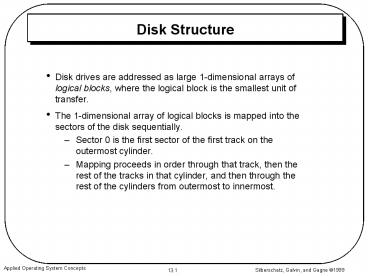Disk Structure - PowerPoint PPT Presentation
1 / 21
Title:
Disk Structure
Description:
1) defective sectors - nearby spare sectors are substituted for the ... Access time has two ... with the minimum seek time from the current head position. ... – PowerPoint PPT presentation
Number of Views:61
Avg rating:3.0/5.0
Title: Disk Structure
1
Disk Structure
- Disk drives are addressed as large 1-dimensional
arrays of logical blocks, where the logical block
is the smallest unit of transfer. - The 1-dimensional array of logical blocks is
mapped into the sectors of the disk sequentially. - Sector 0 is the first sector of the first track
on the outermost cylinder. - Mapping proceeds in order through that track,
then the rest of the tracks in that cylinder, and
then through the rest of the cylinders from
outermost to innermost.
2
(No Transcript)
3
Disk characteristics
- 1) 512 byte sector/block size typical
- 2) gt 100 sectors per track
- 3) gt 2000 cylinders
- 4) almost all use movable R/W heads
4
Disk characteristics
- 1) 512 byte sector/block size typical
- 2) gt 100 sectors per track
- 3) gt 2000 cylinders
- 4) almost all use movable R/W heads
- Translation is complicated by
- 1) defective sectors - nearby spare sectors are
substituted for the defective ones - 2) varying number of sectors per track - inner
collection of tracks (called a zone) have fewer
sectors than outer tracks - 3) Cylinder skew and interleaving
5
Disk Scheduling
- The operating system is responsible for using
hardware efficiently for the disk drives, this
means having a fast access time and disk
bandwidth. - Access time has two major components
- Seek time is the time for the disk are to move
the heads to the cylinder containing the desired
sector. - Rotational latency is the additional time waiting
for the disk to rotate the desired sector to the
disk head. - Minimize seek time
- Seek time ? seek distance
- Disk bandwidth is the total number of bytes
transferred, divided by the total time between
the first request for service and the completion
of the last transfer.
6
Disk Scheduling (Cont.)
- Several algorithms exist to schedule the
servicing of disk I/O requests in order to
improve access time and bandwidth of the disk. - We illustrate them with a request queue (0-199).
- 98, 183, 37, 122, 14, 124, 65, 67
- Head pointer 53
7
(No Transcript)
8
FCFS
Illustration shows total head movement of 640
cylinders.
9
FCFS
- Advantage Fair
- Disadvantage Lots of R/W head movement (640 head
movements)
10
SSTF
- Selects the request with the minimum seek time
from the current head position. - SSTF scheduling is a form of SJF scheduling
11
SSTF (Cont.)
12
SSTF
- Advantage Improvement over FCFS, but not optimal
(236 head movements) - Disadvantage may cause starvation of some
requests.
13
SCAN
- The disk arm starts at one end of the disk, and
moves toward the other end, servicing requests
until it gets to the other end of the disk, where
the head movement is reversed and servicing
continues. - Sometimes called the elevator algorithm.
- Illustration shows total head movement of 208
cylinders.
14
SCAN (Cont.)
15
C-SCAN
- Provides a more uniform wait time than SCAN.
- The head moves from one end of the disk to the
other. servicing requests as it goes. When it
reaches the other end, however, it immediately
returns to the beginning of the disk, without
servicing any requests on the return trip. - Treats the cylinders as a circular list that
wraps around from the last cylinder to the first
one.
16
C-SCAN (Cont.)
17
C-LOOK
- Version of C-SCAN
- Arm only goes as far as the last request in each
direction, then reverses direction immediately,
without first going all the way to the end of the
disk.
18
C-LOOK (Cont.)
19
Your Turn!
- Assume
- a 100 cylinder disk (0-99)
- Starting point cylinder 21
- Sequence
- 35,17,25,50,2,40,23
- Calculate total head movement for
- FCFS
- SSTF
- Scan
- C-scan
- Look
- C-look
20
Your Turn!
- Assume
- a 100 cylinder disk (0-99)
- Starting point cylinder 21
- Sequence
- 35,17,25,50,2,40,23
- Calculate total head movement for
- FCFS (170)
- SSTF (76)
- Scan (175)
- C-scan (196)
- Look (77)
- C-look (92)
21
Selecting a Disk-Scheduling Algorithm
- SSTF is common and has a natural appeal
- SCAN and C-SCAN perform better for systems that
place a heavy load on the disk. - Performance depends on the number and types of
requests. - Requests for disk service can be influenced by
the file-allocation method. - The disk-scheduling algorithm should be written
as a separate module of the operating system,
allowing it to be replaced with a different
algorithm if necessary. - Either SSTF or LOOK is a reasonable choice for
the default algorithm.































